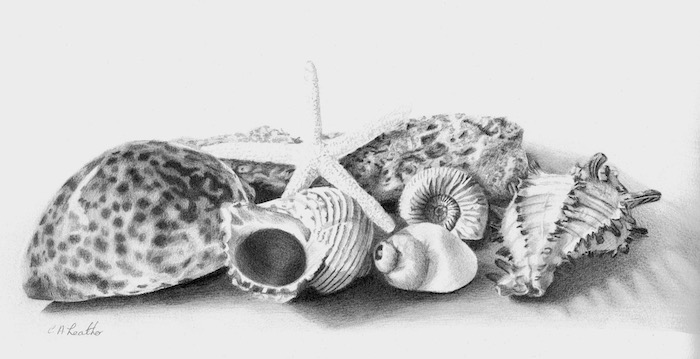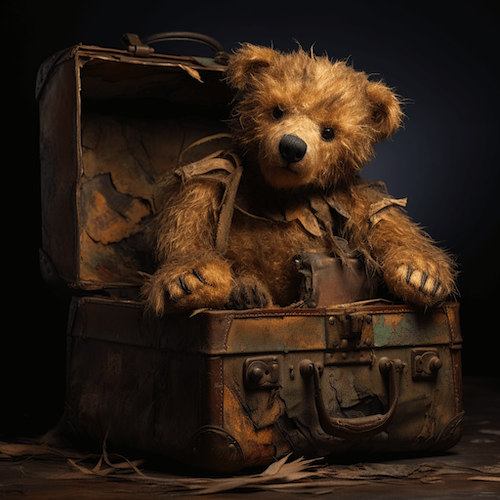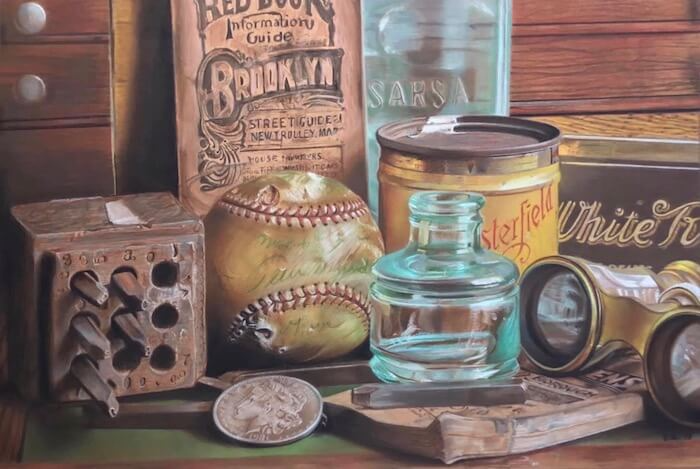- Home
- Tips & Articles
- Still Life Objects
Choosing Still Life Objects Filled with Memory and Meaning
To me, still life felt like a classroom exercise. I’d dutifully line up a few waxy apples, stressing over 'correct' perspective rather than connecting with what I saw.
The problem was… fruit didn’t really mean anything to me. The pleasure was in eating it, not drawing it.
That changed the day I set up a still life with seashells and natural objects I’d collected on holidays over the years. Suddenly, I wasn’t just drawing objects anymore. I was drawing memories.
There was the ammonite I bought in a little gift shop in Devon, just before walking down to the base of the glen to find the secret waterfall. As I drew its curves and shadows, I felt myself slipping back to that moment — the cool air, the sound of water, the excitement of discovering something hidden. Every shell and stone on the page pulled me back to a different place and time.

And perhaps that is the magic of still life: it didn't just ask me to stop and look, it invited me to remember.
It also freed me from the pressure of making a 'pretty arrangement,' reminding me that a still life doesn't have to be merely decorative.
A still life drawing can stir just as much emotion as a cute baby animal portrait — sometimes more — when the objects you choose carry your own stories.
So rather than automatically grabbing fruit or flowers, try this:
Look around your home for objects that have quietly travelled through your life with you.
When you find something that calls to you, sit with it for a moment. Feel the invisible weight it carries. Does it transport you to a specific person or place? Does it stir joy, or perhaps nostalgia? Perhaps it was a silent witness to a major turning point.
Once you’ve gathered a few of these meaningful objects, your job isn’t just to “shade them nicely.” It’s to find a way to translate those layered feelings onto paper — through your choice of composition, shading, edges and colour.
If your mind goes blank at first, that’s normal. Give yourself a moment to wander through your own memories, the way I did with my seashells and that Devon ammonite. Very often, the best still life ideas are already sitting on your shelves, quietly waiting to be noticed.
The Emotional Impact of Still Life Objects
Start with the things that hold your oldest stories.
A childhood teddy bear, with its tattered fur and faded colours, isn't just a toy to be sketched; it’s a direct line back to days of innocence. As you render those worn patches, you might find yourself flooded with a warm, quiet nostalgia that a bowl of fruit simply can’t touch.
 Include your childhood toys in your still life drawings
Include your childhood toys in your still life drawingsBut meaningful art doesn't always have to be happy.
There is a raw beauty in capturing the full depth of human experience, including sadness.
Drawing a broken holiday ornament from a past relationship, for example, can be a way to process loss. By focusing on the cracks and imperfections in precise detail, you aren't just drawing an object; you are honoring the history it represents.
Then there are the small scraps of paper that transport us instantly.
A faded ticket stub from a Rolling Stones concert in 1997 might look like litter to someone else. But to you? That crinkled slip of paper brings back the atmosphere of Soldier Field, the opening riffs of 'Satisfaction,' and the friends who were standing right there beside you.
It’s not just tickets, either. Old maps, postcards, and pamphlets can preserve the geography of a memory in a way a photograph never quite does.
 'A boy's dream' by Ed Kramer, where he drew these special items belonging to a friend, as a gift using pastel pencils
'A boy's dream' by Ed Kramer, where he drew these special items belonging to a friend, as a gift using pastel pencilsFinally, look for the seasonal markers that quietly keep time in your life.
It might be a pair of well-loved flip flops caked in sand, sitting beside a smooth pebble from the beach. Or perhaps a dog-eared paperback you couldn't put down during a lazy July afternoon, or an empty glass pitcher that once fizzed with lemonade.
Whether it’s a humble picnic basket that captures the spirit of summer evenings, or a plastic pumpkin bucket that has seen decades of trick-or-treating, these objects are vessels. They hold more than just light and shadow, they hold your life.
How Personal Items Reflect Your Identity
There is another layer to this, too.
While some objects pull you back to yesterday, others are quietly telling the story of who you are right now. They act as messy, physical evidence, proof of what you value, what you love, and what you’re quietly obsessed with.
With that realization, the pressure for things to look 'expensive' or 'classic' falls away. All that matters is that they tell the lived-in truth of your life.
Take the kitchen, for instance.
A pristine, store-bought bowl of fruit is fine, but it doesn't say much.
That gravy-stained cookbook? Or a worn wooden spoon that has stirred a thousand pots of soup? Those aren't just utensils. They are evidence of your generous spirit and the simple joy of feeding the people you love.
The same applies to the things that feed your mind.
A stack of vintage vinyl or an antique flute speaks to your creative soul.
A tattered paperback mystery isn't just a book; it’s a portal you’ve traveled through, its dog-eared pages holding traces of the wisdom and emotion you absorbed along the way.
Look at the gear you use to engage with the world, too. Muddy soccer cleats or a pair of rusted pruning shears aren't 'messy', they are symbols of your dedication. They show what you nurture and what you strive for, whether that's a thriving garden or a personal best.
And sometimes, the most powerful still life subjects are the ones that represent the heartbeat at your feet. A frayed leash or a well-chewed squeaky toy captures the chaotic, unconditional love of a pet in a way a formal portrait sometimes misses.
So don't just look for the things that look nice. Look for the things that look like your life.
Making Your Artwork a Personal Statement
Your possessions have stories to tell, if you’re willing to listen.
So the next time you pick up your pencils, look past the surface. Don't just worry about the lighting or the angles. Look for the history. Draw the scratches that show where an object has been, and the wear that shows how much it was loved.
Technical perfection is impressive, but meaning is what makes us stop and stare. Your life is already full of art. You just have to draw it.
Improve Your Pencil Art: Get Free Tips & Techniques
Sign up for our newsletter – just occasional emails packed with practical advice and inspiration for pencil artists like yourself
